The call came on a Sunday evening back in the fall. “This is Xishuo. It’s started – can you come over?” “We’ll be there in about 15 minutes,” I responded.
“It” was the spectacular blooming of one of Xishuo’s moon flower plants (Epiphyllum oxypetalum) (Wikipedia, 2012a). These plants, originally from Central America, are fairly popular house plants, and not because of their general appearance. Most of the time they are a large, unkempt arrangement of broad, somewhat cactus-like leaves which double as stalks. But one night a year they produce one or a few spectacular white flowers which bloom just once over a few hours. Xishuo (Wang), a colleague and friend, had told me that one of his plants was producing a couple of buds, unseasonably as flowering normally occurs in summer. He had recently given me a cutting which I was growing at work, and since then I had become extremely curious to actually see one of these plants flowering.
So my wife Tulimah and I drank tea and chatted with Xishuo and his wife Shuyuan, and watched the flower lifting and opening, and took photos (Fig. 1). At one point Xishuo made an offhand remark that, “Of course, all this is done with hydraulics.” I had a mini-revelation at that point, because I hadn’t consciously considered that plants don’t have muscles and bones and their associated lever operations, yet some are capable of fairly rapid movement. I have a little Venus flytrap (Dionaea muscipula) (Wikipedia, 2013c) (Fig. 2) at work that can close on insects, and here was a much larger flower opening almost fast enough to actually see the movement. Animal bodies perform certain operations hydraulically (no need to go into that), but plants rely entirely on hydraulic mechanisms to move, which they do, usually slowly but sometimes quite quickly. A Venus flytrap snaps shut in 100 ms to eat, the Dogwood Bunchberry flower opens and fires pollen in 500 μs (Wikipedia, 2012c). The stamens in the White Mulberry, whose leaves are the feedstock for silk worms, act as catapults to shoot out pollen within 25 μs, resulting in an escape velocity of over half the speed of sound (Wikipedia, 2013a)!
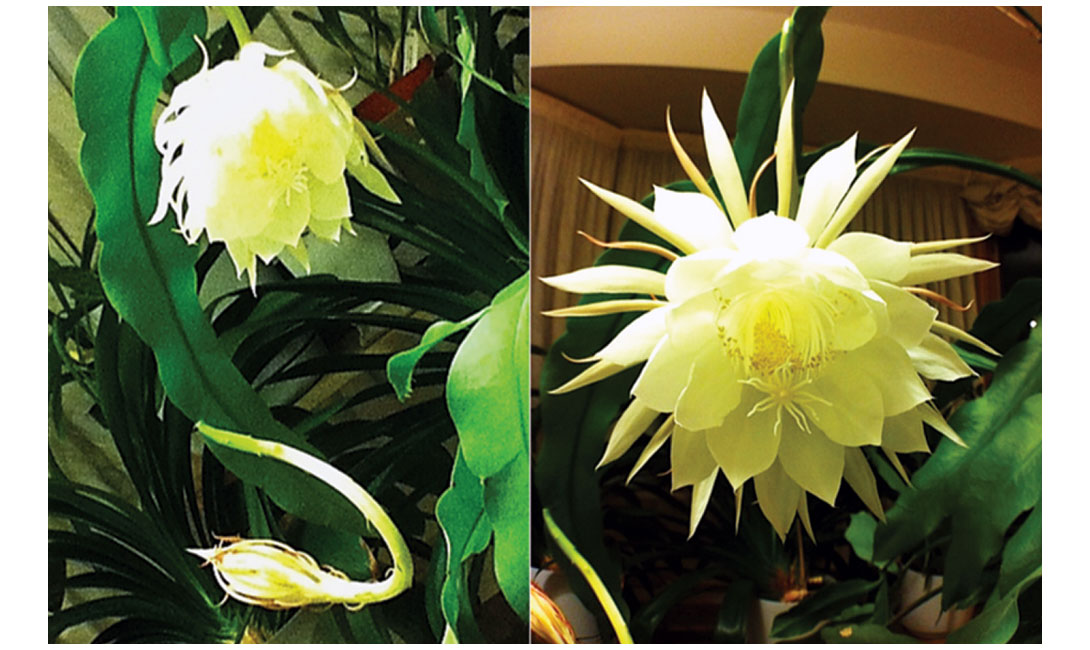
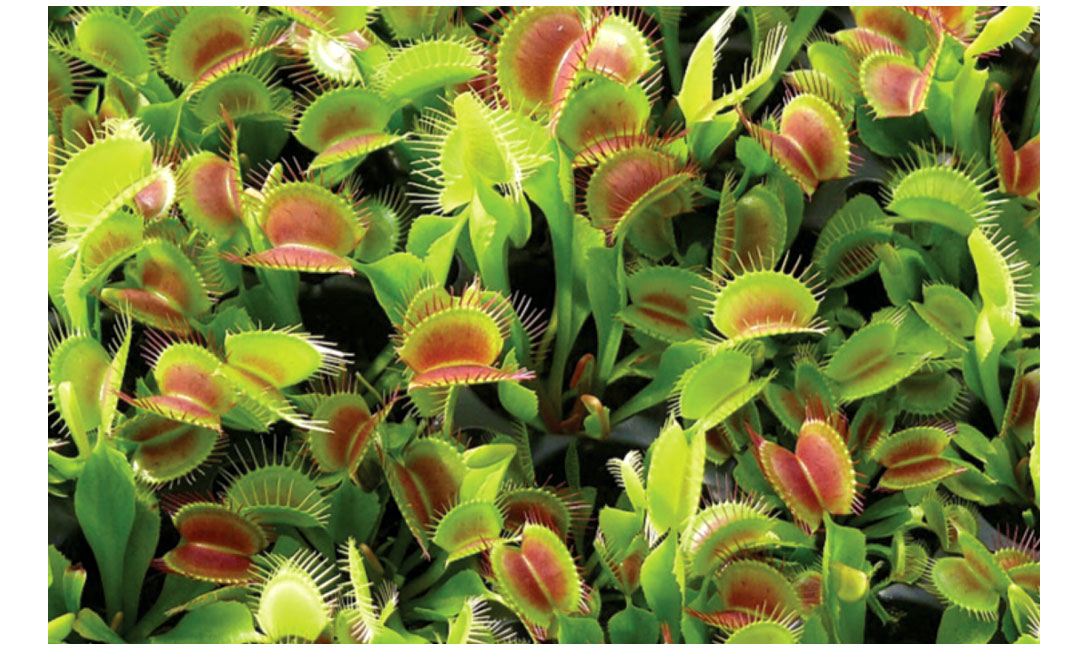
Innumerable plants are heliotropic, that is they move to follow the sun; some plants exhibit leaf heliotropism, others floral heliotropism. It makes sense that plants would maximise photosynthesis by keeping the broadest face of their leaves always turned towards the sun, but moving flowers to face the sun is less obvious. In certain tropical plants the flowers don’t actually follow the sun, they maintain a particular azimuth and declination relative to it, as this allows the parasol of the flower to shade reproductive parts such as the gynoecium (Wikipedia, 2012b) which would be damaged by heat. Some plants at higher latitudes are known to have parabolic shaped flowers which rotate so that the sun’s rays enter the flower and are focused on the reproductive parts, just like a satellite dish; without the added warmth pollination wouldn't be possible. Facing blooms and buds towards the sun increases the chance of pollination, for many reasons – enhancing the attractiveness of the display to insects, accelerating seed growth via heat, rewarding pollinating insects with pleasant warmth, etc.
All sorts of creepers send out tendrils which sense and curl around whatever anchors they can find. The mechanisms by which plants sense their surroundings are highly interesting. We tend to think of plants as dumb and passive organisms, yet they are arguably able to sense and react to their environments just as effectively as animals. “Examples of stimuli which plants perceive and can react to include chemicals, gravity, light, moisture, infections, temperature, oxygen and carbon dioxide concentrations, parasite infestation, physical disruption, and touch. Plants have a variety of means to detect such stimuli and a variety of reaction responses or behaviors” (Wikipedia, 2013b).
These amazing reactions triggered by all these senses fall under the general term tropism – chemotropism, phototropism, electrotropism and so on. A favourite thigmotropism (response to touch) of mine is that of Mimosa pudica (Fig. 3), which is pervasive in SE Asia, often forcing itself into mown grass areas as a ground cover. Waiting for the bus before and after work in Singapore I couldn’t resist brushing my foot against these plants, which react immediately by folding their leaves shut. (For a slow motion video clip, go to http://en.wikipedia.org/wiki/ File:Mimosa_Pudica.gif ) This gives me the same sense of satisfaction as cracking the ice in frozen puddles did on the way to school as a boy. Some plants (e.g. tomatoes) when under attack (insects, mould, etc.) give off chemical warnings to their nearby kin, which respond by producing and distributing chemical defences to their extremities, just like a nation might muster its armed forces upon receiving military intelligence of an impending attack.
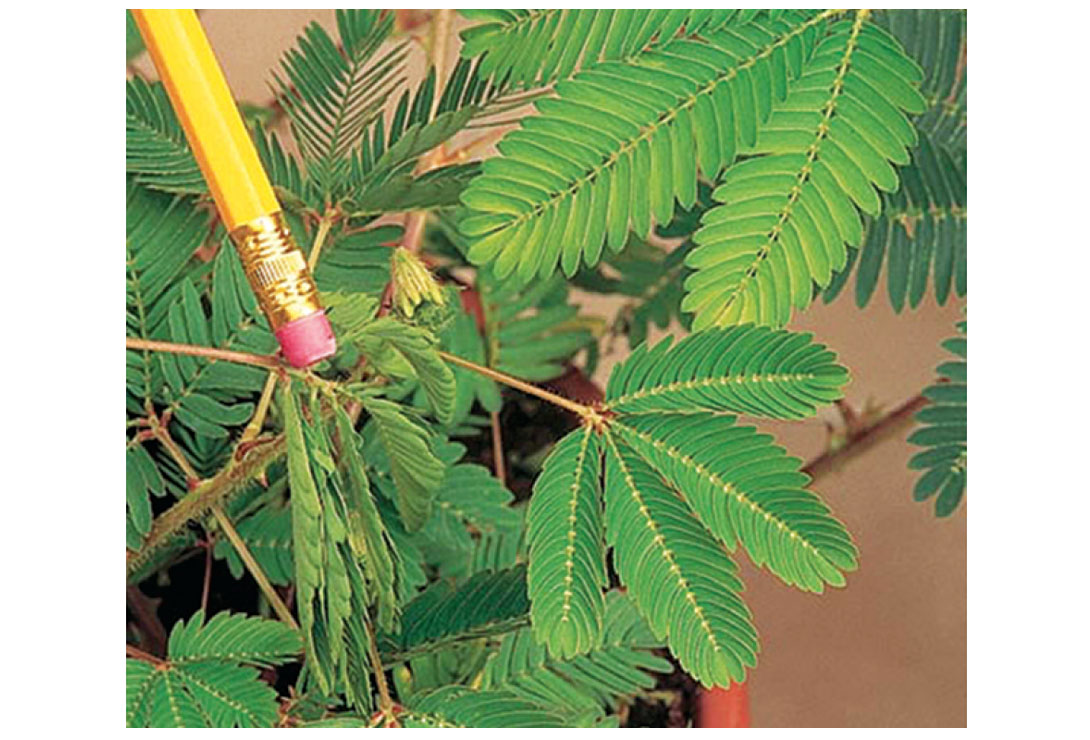
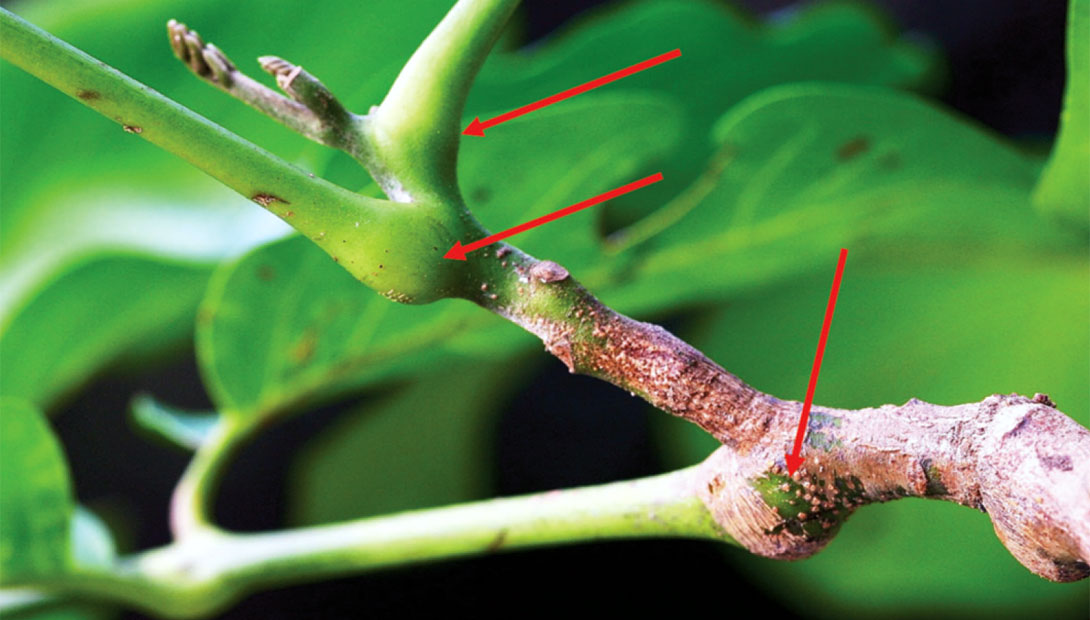
But let’s get back on topic – plant movement and hydraulics! Some components of plant movement can be attributed to growth (i.e. tendrils to a certain extent grow around what they are grabbing), but all other movement is achieved via hydraulics. In the case of floral heliotropes, there is a motor cell called a pulvinus in the stem just below the flower. Photosensitive cells trigger the pulvinus to pump potassium ions into the stem cells on the sunny side. This decreases turgor pressure and the sunny side cells become somewhat flaccid, causing the flower to turn towards the sun.
In fact, most or all non-growth plant movement is generated by pulvinus mechanisms, with variations depending on the type of movement. In some situations, rather than flaccidity, movement is achieved with the opposite – an increase in turgidity and in some cases an elongation of cells (gynoecium, flaccid, turgid, elongation...good gracious!)
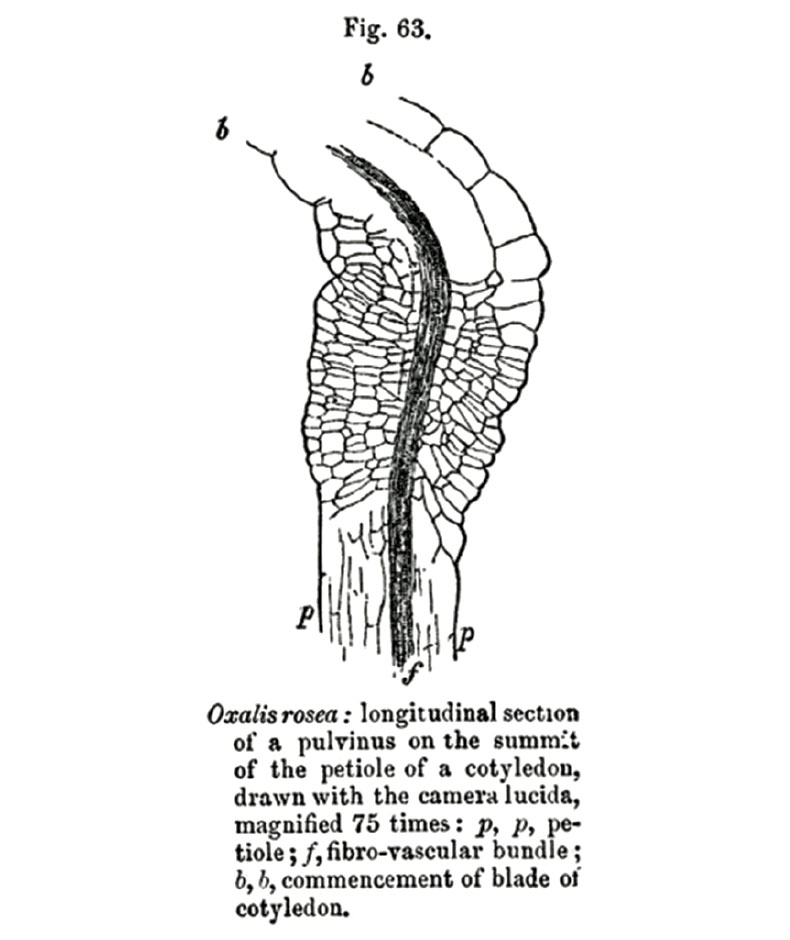
A pulvinus is seen as a thickening of the plant stem (or other structure) at the base of the component to be moved (leaf, petiole, flower, etc.) – see Figures 4 and 5. Figure 5 is of historical interest as it was created by Charles Darwin himself. The diagram in Figure 6 of two neighbouring cells will aid in understanding how the pulvinus achieves movement.
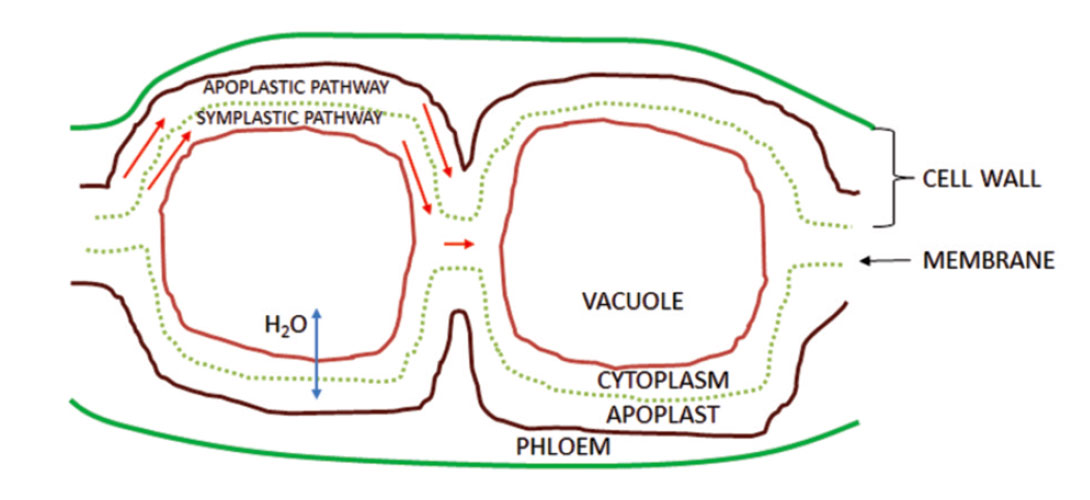
Everything relies on establishing a difference in osmotic pressure on either side of a semi-permeable membrane. The membrane allows water to move through it, but not a solution composed of a potassium ion solute and water solvent. The relative concentration of the solute on either side of the membrane establishes the osmotic pressure gradient or tonicity: if the solution on the outside of the membrane is relatively high in solute (hypertonic) then water will be pulled out of the cell towards the hypertonicity in order to balance the solute concentration – this is referred to as exosmosis; if the solute levels on the outside of the membrane are relatively low (hypotonic) then water will be pulled into the cell – endosmosis. So, a step by step sequence could be:
- On one side of the pulvinus the phloem secretes sucrose into the apoplast.
- The sucrose solution pulls potassium (K) in from surrounding cells, which is ionised as it dissolves into the sugary water solvent. The K solution travels through the apoplastic pathways surrounding all the many cells as seen in the Darwin diagram.
- Osmotic pressure within the apoplast is decreased due to the increase in solute concentration.
- The osmotic pressure gradient across the membrane draws water out of each cell’s cytoplasm and especially vacuole, and into the apoplast.
- The vacuoles shrink and the cells become flaccid.
In pulvinic cells the vacuole acts as a bladder which expands and contracts as needed. In some pulvini the concentration of K directly inside of the vacuoles can be increased which creates hypertonicity, thus drawing water in to the vacuole (endosmosis), increasing turgor. In some plants the cell walls and vascular cores are designed to change shape when turgidity increases, allowing cellular elongation, which allows for different types of movement.
In many plants if the barrier between the vacuole and surrounding cell protoplasm is breached (say by a herbivore, a pest, a fungus, or a chef), then a chemical reaction takes place (Wikipedia, 2012d).
For example, in garlic alliin and alliinase are normally separate; if the vacuole wall is broken the two combine to form allicin, which is a toxin, and besides its pungent odor also has anti-fungal and anti-bacterial properties. Many of the flavours we use in cooking are a result of this kind of plant defense mechanism – e.g. onions, garlic, mustard, horse radish, etc.
In all non-woody plants osmotic pressure mechanisms are used within non-pulvinic structural cells to maintain a certain level of rigidity. This is why plants that lack water tend to droop – they simply don’t have enough water to maintain turgor within their structural cells. Once watered they perk up again. In the case of the moon flower, and other opening flowers, pulvinus mechanisms are largely unnecessary. Instead, unused structural cells within the bud are just waiting, like uninflated balloons, for the time to flower. Once the signal is received, fluids flow into the cells through the apoplastic and sympoplastic pathways, turgidity increases, the flower lifts, and the petals and tendrils unfurl in their spectacular display.
References
Wikipedia. (2012a, April 21). Epiphyllum. Retrieved January 12, 2013, from Wikimedia Foundation, Inc.: http://en.wikipedia.org/wiki/Epiphyllum
Wikipedia. (2012b, December 12). Heliotropism. Retrieved January 12, 2013, from Wikimedia Foundation, Inc.: http://en.wikipedia.org/wiki/Heliotropism
Wikipedia. (2013a, January 10). Morus alba. Retrieved January 12, 2013, from Wikimedia Foundation, Inc.: http://en.wikipedia.org/wiki/Morus_alba
Wikipedia. (2008, February 5). Fig.63 Movement of Plants. Retrieved January 13, 2013, from Wikimedia Foundation, Inc.: http://en.wikipedia.org/wiki/File:Fig63Movement_of_Plants.png
Wikipedia. (2013b, January 3). Plant perception (physiology). Retrieved January 12, 2013, from Wikimedia Foundation, Inc.: http://en.wikipedia.org/wiki/Plant_perception_(physiology)
Wikipedia. (2012c, December 22). Rapid plant movement. Retrieved January 13, 2013, from Wikimedia Foundation, Inc.: http://en.wikipedia.org/wiki/Rapid_plant_movement
Wikipedia. (2012d, December 29). Vacuole. Retrieved January 13, 2013, from Wikimedia Foundation, Inc.: http://en.wikipedia.org/wiki/Vacuole
Wikipedia. (2013c, January 7). Venus Flytrap. Retrieved January 12, 2013, from Wikimedia Foundation, Inc.: http://en.wikipedia.org/wiki/Venus_Flytrap
Next month’s article: Encryption











Share This Column